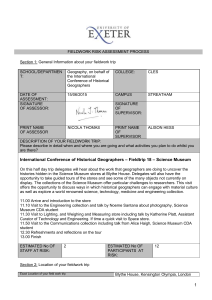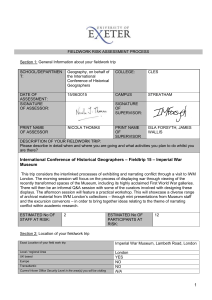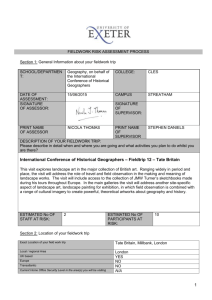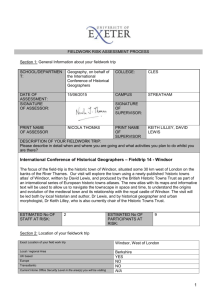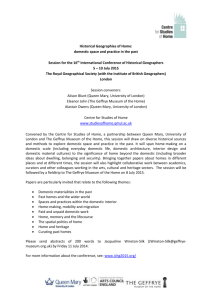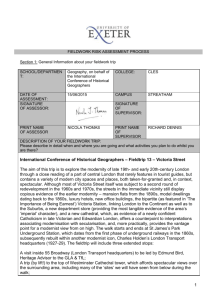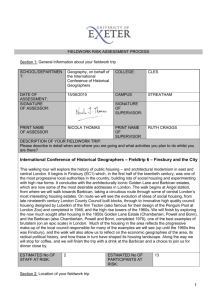Geffrye Museum - International Conference of Historical
advertisement
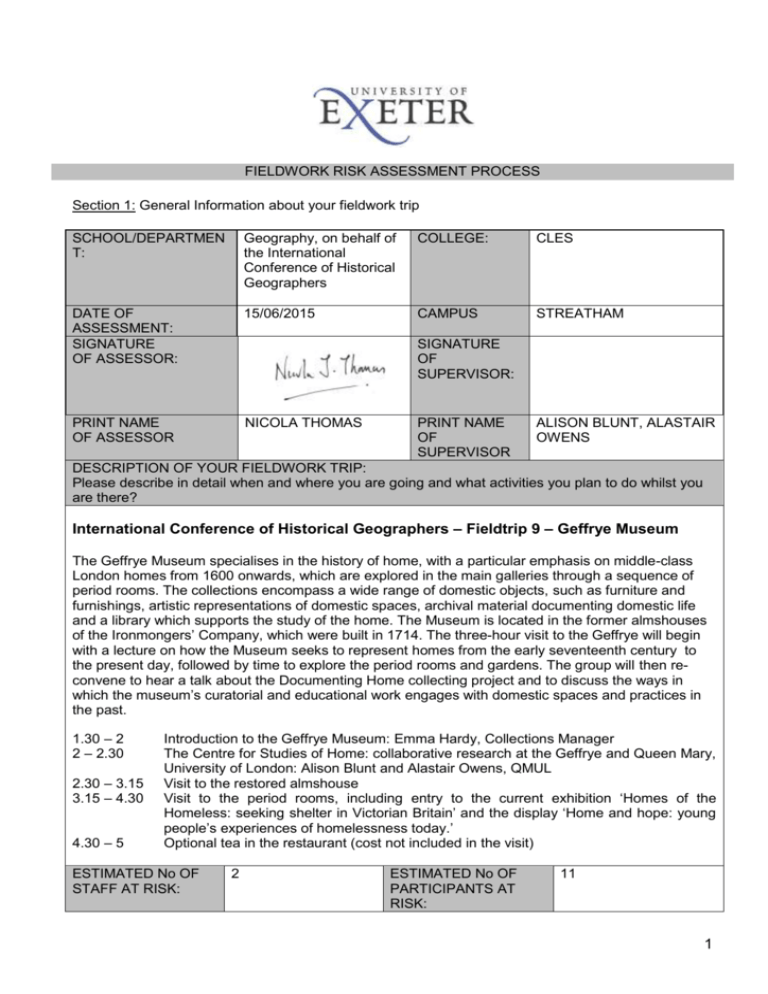
FIELDWORK RISK ASSESSMENT PROCESS Section 1: General Information about your fieldwork trip SCHOOL/DEPARTMEN T: Geography, on behalf of the International Conference of Historical Geographers COLLEGE: CLES DATE OF ASSESSMENT: SIGNATURE OF ASSESSOR: 15/06/2015 CAMPUS STREATHAM PRINT NAME OF ASSESSOR NICOLA THOMAS SIGNATURE OF SUPERVISOR: PRINT NAME OF SUPERVISOR ALISON BLUNT, ALASTAIR OWENS DESCRIPTION OF YOUR FIELDWORK TRIP: Please describe in detail when and where you are going and what activities you plan to do whilst you are there? International Conference of Historical Geographers – Fieldtrip 9 – Geffrye Museum The Geffrye Museum specialises in the history of home, with a particular emphasis on middle-class London homes from 1600 onwards, which are explored in the main galleries through a sequence of period rooms. The collections encompass a wide range of domestic objects, such as furniture and furnishings, artistic representations of domestic spaces, archival material documenting domestic life and a library which supports the study of the home. The Museum is located in the former almshouses of the Ironmongers’ Company, which were built in 1714. The three-hour visit to the Geffrye will begin with a lecture on how the Museum seeks to represent homes from the early seventeenth century to the present day, followed by time to explore the period rooms and gardens. The group will then reconvene to hear a talk about the Documenting Home collecting project and to discuss the ways in which the museum’s curatorial and educational work engages with domestic spaces and practices in the past. 1.30 – 2 2 – 2.30 2.30 – 3.15 3.15 – 4.30 4.30 – 5 Introduction to the Geffrye Museum: Emma Hardy, Collections Manager The Centre for Studies of Home: collaborative research at the Geffrye and Queen Mary, University of London: Alison Blunt and Alastair Owens, QMUL Visit to the restored almshouse Visit to the period rooms, including entry to the current exhibition ‘Homes of the Homeless: seeking shelter in Victorian Britain’ and the display ‘Home and hope: young people’s experiences of homelessness today.’ Optional tea in the restaurant (cost not included in the visit) ESTIMATED No OF STAFF AT RISK: 2 ESTIMATED No OF PARTICIPANTS AT RISK: 11 1 Section 2: Location of your fieldwork trip Exact Location of your field work trip Geffrye Museum, East London Local / regional Area London YES NO NO N/A UK based Europe Transatlantic Current Home Office Security Level in the area(s) you will be visiting Section 3: the Hazards involved in the work you are planning Highlight the relevant hazards in the list below Climate: Based indoors. Terrain/Location: Fieldtrip will be indoors. There may be uneven pavements and steps. Participants will visit public buildings. Biological: NONE Chemical: NONE Mechanical: NONE Electrical: NONE Human Activity: Participants will be in together in a group. This can mean that individuals cease paying attention to their own safety. Recreation: NONE Work Procedures: Participants will be travelling as a group. We will be in an urban location so a possible hazard could be assault or theft. People may have less awareness of their position and step into the road or slip off pavements. There is a risk of injury in relation to trips and falls and accidents involving cars. Work Abroad: n/a Other Stressors: General: Pre-existing conditions, Food intolerance/allergy Behaviour: Participants are adults from different countries. There may be unanticipated differences or misunderstandings. Legal problems: NA Security: NA 2 Section 4 – Your assessment of the risks (Risk Assessment) 1 Hazard number What is the hazard (e.g. low temperature, falling rocks) 1. (C) Consequenc e (1-5) X 3 X 5 X (L) Likelihood (1-5) = (RS) Risk Score (1-25) Action to be taken to control the risk (please list all actions you will be taking) Residual Risk (the remaining risk once your controls are put in place) C X L = RS 2 = 5 1 x 1 = 1 1 = 5 Participants asked to carry water and wear comfortable footwear for the visit of the museum. Participants warned about the risk. 1 X 1 = 1 Climate: indoors. 2. Terrain/Location: Field leader to identify emergency exit codes in any buildings visited and to alter participants to these. Fieldtrip will be indoors. There may be uneven pavements and steps. Participants will visit public buildings. 3. 5 X 1 = 5 Participants alerted to risk. Field leaders to alert participants of potential risks and direct them clearly to safe routes. 1 X 1 = 1 5 X 1 = 5 Participants warned about the risk. 1 X 1 = 1 1 X 1 = 1 Participants asked to disclose pre-existing medical /dietary conditions which may cause risk . Participants have been asked to indicate dietary requirements so allergic reactions are unlikely to be a problem. Field leaders will be reminded to call emergency services should any need arise, 1 X 1 = 1 Human activity: Participants will be in together in a group. This can mean that individuals cease paying attention to their own safety. 4. 5. Work Procedures: lack of awareness, slipping in an unfamiliar environment. General: Pre-existing conditions, Food intolerance/allergy, Foot problems, Lack of fitness, exhaustion. 3 6. Behaviour: Participants are adults from different countries. There may be unanticipated differences or misunderstandings. 1 X 1 = 1 This is unlikely to cause difficulties as participants share a common bond. Field leader to be aware of group dynamics and to diffuse any tensions. 1 X 1 = 1 4 5
